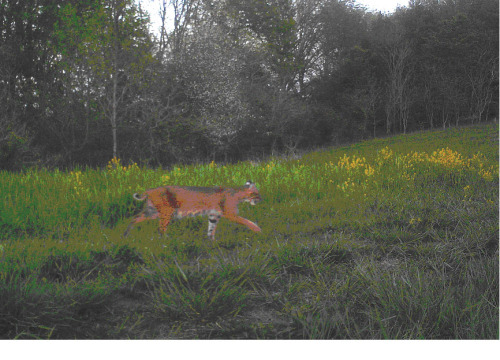Bobcats in Indiana
By Shawn Rossler
Bobcats, our only resident native wild cat, are a species of great curiosity. Generally a solitary animal, the secretive nature of bobcats often leaves Hoosiers wanting to know more about these unique mammals.
A few key characteristics set these wild cats apart from other felids, one of which is their distinctive tail. Only 5 to 7 inches and having a black tip, the tail of a bobcat is their most well known trait.
Relatively consistent features in the species coloration also distinguish them from other cats. Bobcats are generally a brownish tan color, with black spotting. Black spots can vary from distinct to a dull color, but are usually visible on the white under belly. Additionally, a series of black bars can usually be seen on the inside of their front legs. Bobcats also have a well defined white band on the backside of each ear. Collectively, all of these features can be used to correctly identify a bobcat.
As a general rule, bobcats will weigh between 15 and 35 pounds, stand approximately 2 feet tall, with an overall body length of 3 feet. The physical build and size of a bobcat cannot accurately determine their gender, but female and juvenile animals are typically smaller than mature males. The size of each individual will vary.
Equipped with large eyes, bobcats are mostly nocturnal, but they can be active and hunt during the day. According to Scott Johnson, a nongame mammal biologist with the Indiana Department of Natural Resources (IDNR), “an analysis of over 100 bobcat stomachs has shown their diet is primarily composed of mammals including rabbit, mice, voles, and squirrel. We did find the remains of several bird species, but only in a small percentage of the bobcat stomachs examined.” Johnson also noted that bobcats, like many predators, are opportunistic and will scavenge deer carcasses during fall-winter months.  Bobcats have short, black-tipped tails and large white spots behind each ear. The tracks of bobcats are also larger in size than house cats.
Bobcats have short, black-tipped tails and large white spots behind each ear. The tracks of bobcats are also larger in size than house cats.
What’s their status?
Indiana has historically been home to bobcats, but unregulated take and habitat loss caused their numbers to drop by the mid-1900s. These low population levels landed them on the state’s endangered species list in 1969, where they remained until 2005.
Bobcats are still a protected species in the state, meaning they cannot be hunted or trapped. Their current status as well as increases in the amount of habitat available has allowed them to further increase their range in the state. Between 1970 and 2012, the IDNR confirmed bobcat reports in 52 Indiana counties.
A study conducted by the IDNR in south central Indiana revealed that bobcats are capable of dispersing distances upwards of 50-100 miles. This ability to cover long distances allows them to recolonize available habitat. It also puts them in close proximity to roadways. Vehicle collisions are now a common cause of bobcat mortalities.
Recent trends in reported bobcat road-kills and other related mortalities suggest the bobcat population is continuing to expand. In the early 2000s (2001-2005), the IDNR received roughly 15-20 reports of bobcat mortalities each year. In 2010, 2011, and 2012 more than 70 bobcat mortalities were reported annually. A majority of these mortalities were in the southern third of the state where the hills, mixed woodlots, and reclaimed mines provide great habitat.
What should You know as a landowner?
Although bobcat reports are more common in the southern portion of the state, confirmed reports have been received from west central and northern regions. The current distribution of bobcats, coupled with forests patches and river systems corridors, provide good opportunities for bobcats to disperse into other areas of the state.
Many Hoosiers have the potential to see a bobcat, but their secretive nature still makes catching a glimpse of these animals an infrequent event. As with all wildlife, if you happen to see a bobcat it should be respected, but landowners shouldn’t be afraid as the natural response of a bobcat is to flee from humans.
Recovering bobcat populations across the state is a good thing, but it can generate questions about livestock predation, safety of pets, and impacts on game birds. Conflicts between bobcat and livestock are currently a rare event, and recent results from stomach content analysis indicate bobcat diet in Indiana focuses primarily on smaller mammals, rather than bird species. To date, the IDNR has received no verified accounts of bobcats injuring a pet.
The recovery of the bobcat is a great conservation success story for the Hoosier state.
The IDNR continues to collect information on bobcats and asks for your help in documenting mortalities and sighting. Any confirmed bobcat sighting including trail cameras, observed road-kills, or a report of an animal that has been incidentally trapped is very useful to the IDNR. These observations can be reported by contacting the IDNR at (317) 232-4200 or on dfw@dnr.in.gov.
Shawn Rossler is the furbearer biologist for the Indiana Department of Natural Resources, Division of Fish and Wildlife.
